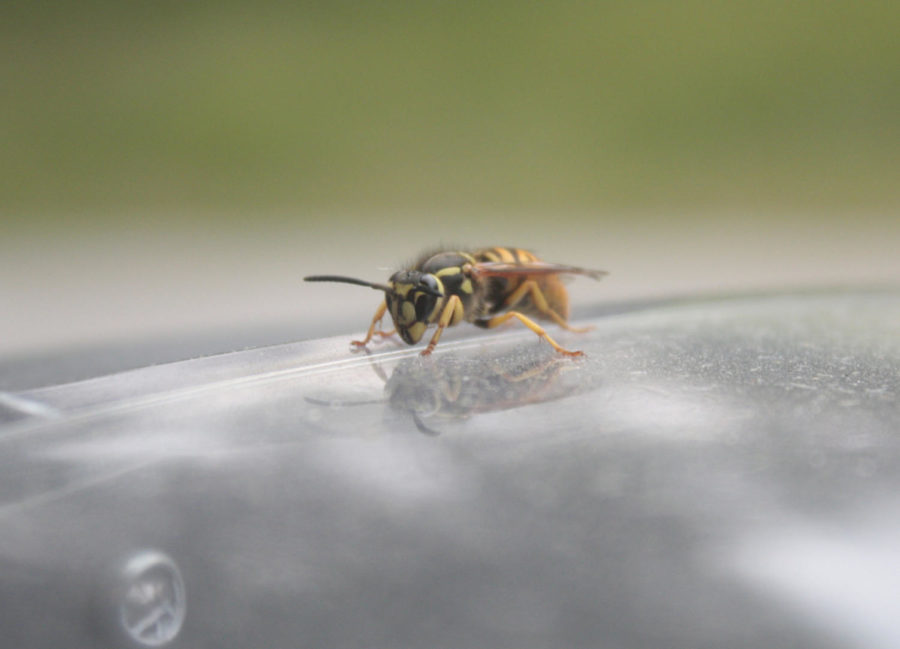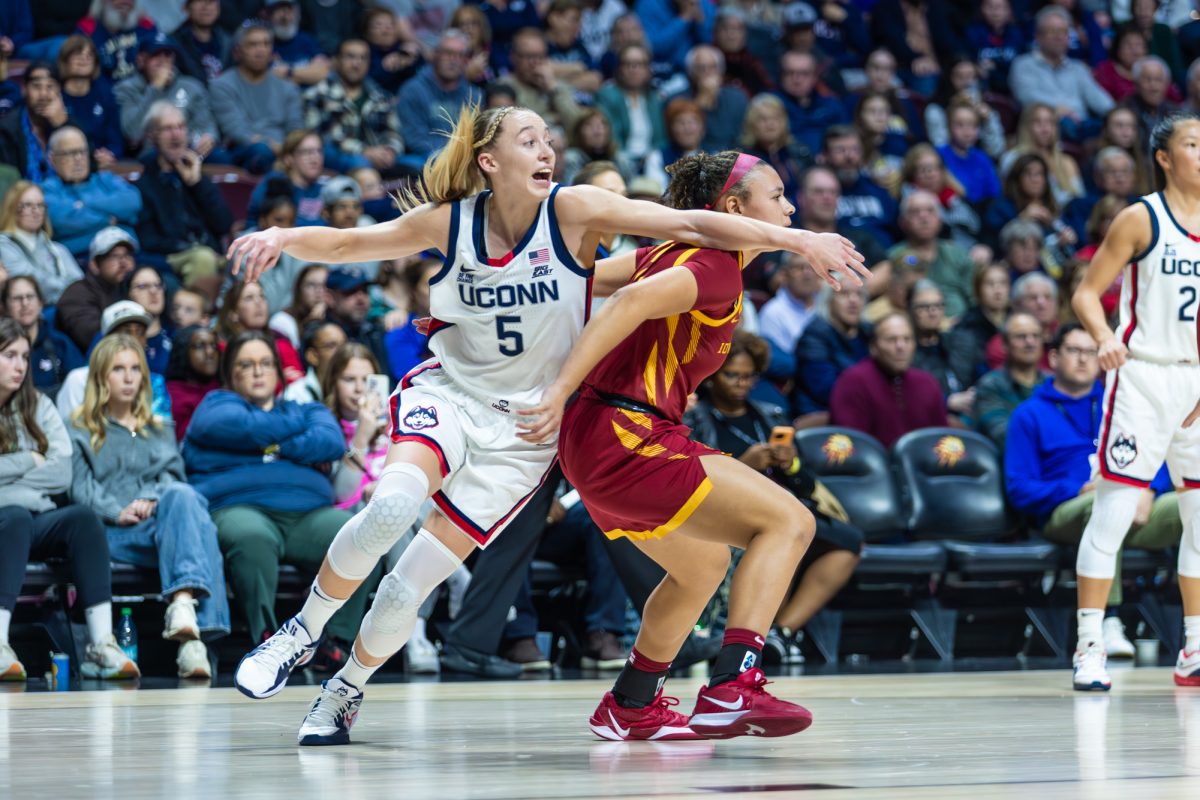Wasps, not bees, swarm campus for food
Mariah Griffith/Iowa State Daily
A yellow jacket wasp lands on a recycling bin on central campus on Oct. 6.
October 5, 2015
Last week, the Daily printed a letter detailing the difficulties a student was having with campus wildlife.
In short, the student was annoyed with a bunch of what he thought were “damn bees” trying to get at his food and generally buzzing around.
Entomology department staff members say firstly, they’re not bees, but wasps. Secondly, although annoying, these campus visitors aren’t bad and they won’t be around for long.
“There are thousands of species of wasps, one of which can be very annoying. That’s the yellow jacket,” said Amy Toth, assistant professor of ecology/evolution and organismal biology-agriculture and life sciences.
Her lab’s research focuses on how environmental and genetic factors affect social structures in wasp colonies.
Toth said yellow jacket wasps are more noticeable in the fall because of the colonies’ seasonal growth patterns and the fact that their normal food sources, like nectar and caterpillars, become scarce in colder weather. Thus, yellow jackets turn to humans’ messy habits for alternatives.
“This time of year, [yellow jackets] are very hungry. They are also smart and opportunistic, and when there’s food around they’ll take advantage of it,” Toth said. “They’ll eat almost anything, so anything you find delicious they also find delicious.”
Matthew O’Neal, associate professor of entomology, said this leads the wasps to cluster around garbage cans and communal eating areas, like the newly expanded one outside of the Hub.
“I think what they’ve done is increase the likelihood that the wasps, which are really active this time of year, are going to come into contact with people,” O’Neal said of the new construction.
Students in such areas, including the one who wrote the letter, sometimes say they’re scared of or bothered by the yellow jackets dogged efforts to forage.
“I think what people observe is that they are persistent, and that’s not the same thing as aggressive,” Toth said. “They’re trying to persistently get your food, but it’s all about your food. They’re not being aggressive toward you.”
Toth and O’Neal both said the chance of these wasps stinging a person is low.
“They’re not particularly like, ‘I want to go and sting this person.’ They’re looking for food,” O’Neal said.
Even if a student is stung, Toth said they don’t need to worry about being swarmed because the wasps are foraging rather than protecting a nest.
“What happens a lot of times is you accidentally touch one, accidentally bite one – I’ve done that and it’s never fun,” Toth said. “But if there’s one on campus that happens to sting you, that’s the end. Nothing’s going to happen after that.”
Toth and O’Neal said the best way to avoid the wasps is to move indoors, and even a persistent wasp can likely be gently shooed, flicked or blown away without stinging anyone.
Mikayla Maves, junior in music, is allergic to bee and wasp stings, but said she’s not afraid of the insects.
“When I was 4, I got stung by a bee that got caught in my swimsuit and couldn’t get away,” Maves said. “I broke out in hives and had a hard time breathing, and that’s how I found out I was allergic.”
Maves said she always carries emergency treatment and hasn’t been stung again.
“The best thing is really to just ignore them or stand still,” Maves said. “We’ve all heard it, but if you don’t bug them, they won’t bug you.”
How do you tell what type of bug you’re trying to get to buzz off?
“Bees in general are more hairy, so they look like they’ve got a little Christmas sweater, as opposed to wasps, whose exoskeletons are almost smooth and svelte,” said Erin Hodgson, associate professor of entomology, in an online podcast responding to the Daily letter.
Even though the insects on campus are wasps, is their abundance a good sign for the health of related animals like bees?
“Across the board, pollinators are in decline. That includes butterflies, that includes bees, that includes bats and a variety of other things” Toth said. “The wasps you see are not in decline — they’re clearly doing just fine.”
Toth said more than 200 bee species other than honeybees live in Iowa, and the Italian honeybees commonly used by Iowa beekeepers are suffering some of the worst losses.
Historically, Toth said a sustainable mortality rate for beekeeper’s hives has been about 15 percent of the bees, and current losses are much higher.
“Nation-wide losses have been closer to 30 percent,” Toth said. “In Iowa and the upper Midwest they’ve been 60 or 70 percent and it’s devastating.”
These massive pollinator death rates could take a toll on produce production in the future. According to the American Beekeeping Federation, honeybees alone contribute more than $14 billion to the value or crop production just in the United States. This includes values from a variety of foods like cherries, apples, blueberries, melons, broccoli and almonds in addition to honey.
What could happen if bee mortality rates stay high?
Brittney Rutherford, program coordinator II for ISU Dining, said that even if all local bees died, Iowa State’s dining services would still be able to supply produce from other sources.
That could have a significant economic impact. Rutherford said dining services spends approximately $953,000 on produce a year. About $25,000 of that money is allocated for purchasing local products, a portion of which goes toward purchasing local produce in August and September.
“We are choosing to purchase local when we can, but we could go to all conventional produce without a problem,” Rutherford said. “I’m not sure declining bee populations would have a direct effect — we’d just have to buy produce from somewhere else.”
Toth said that as beekeepers’ hives crash and their services become more expensive, businesses may move toward human pollination methods, like detasseling for blueberries.
“The bees can probably do that job a lot better because their bodies are specialized for it, but replacing them every year isn’t economical,” Toth said. “Bees are not going extinct because they’re found worldwide, but beekeepers are going extinct because of costs.”






